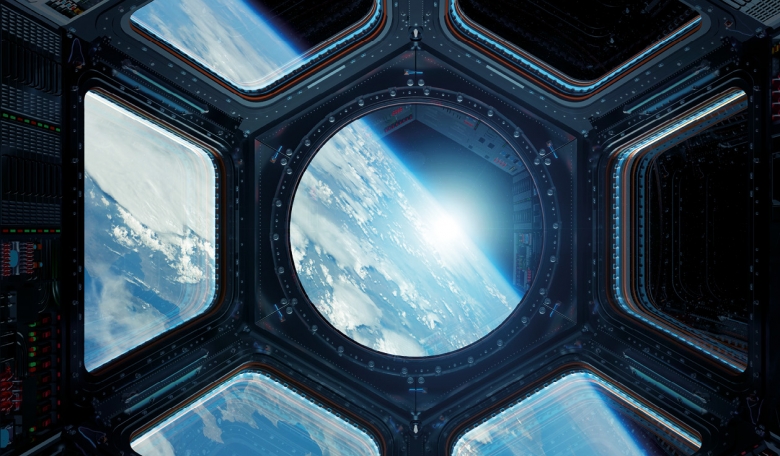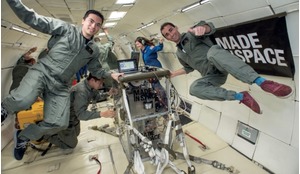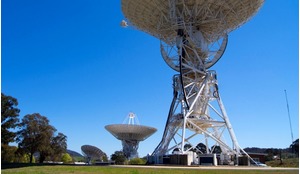The cost of building and operating the International Space Station (ISS) is difficult to pin down, but it may well be ‘north’ of US $200 billion dollars. The additional cost of operating the ISS throughout the 2020s to the end of its life in 2030 alone is essentially $40 billion (or $4 billion a year). If NASA has learned anything from the ISS experience, it is that its scale and operating costs were too large, especially as its lifetime ended up being more than twice its original design-life (32 years rather than 15). However, the NASA of the 2020s is clearly intent on reinventing itself. Today, it is no longer developing ‘technical specifications’ in-house; instead, it is producing ‘performance specifications’ from which private space companies develop competitive designs that NASA selects after a detailed review. This article explores the status of planning and implementation for private space stations, the innovative concepts that are now envisioned for these new space facilities, and the many challenges that lie ahead.
NASA’s new way of doing business has resulted in innovative new space facilities that can be built faster, at lower cost and are arguably better in terms of safety and reliability. The approach was used in the later stages of the Artemis Moon programme for the design and manufacture of the Gateway lunar orbiter, the Human Landing System and for many of the key components from lunar rovers to habitat facilities.
The most innovative aspect of NASA’s approach to future exploration and science programmes is to de-orbit the ISS and replace this outmoded facility with ‘private’ space stations. Indeed, the habitat unit for the Axiom Space private orbital facility is already well under way and is currently being fabricated by Thales Alenia Space. Meanwhile, three other companies are competing for the design of the other private space station that NASA is backing commercially. The three teams are headed by Northrop Grumman (NGC), Blue Origin and Nanoracks. The idea is that NASA orbital science research activities will provide the anchor funding for these two private space stations and that commercial service contracts and income will provide the rest.
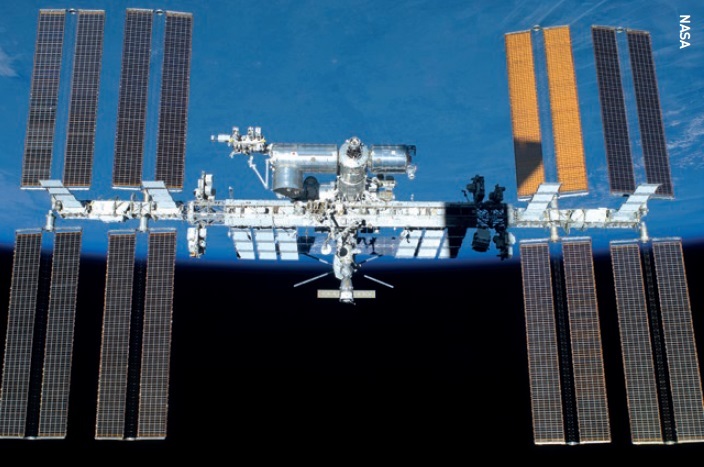 The size and complexity of the United States major space programmes - the International Space Station, Space Launch System and Orion capsule - might have benefited from a better sense of scale and smaller size.
The size and complexity of the United States major space programmes - the International Space Station, Space Launch System and Orion capsule - might have benefited from a better sense of scale and smaller size.
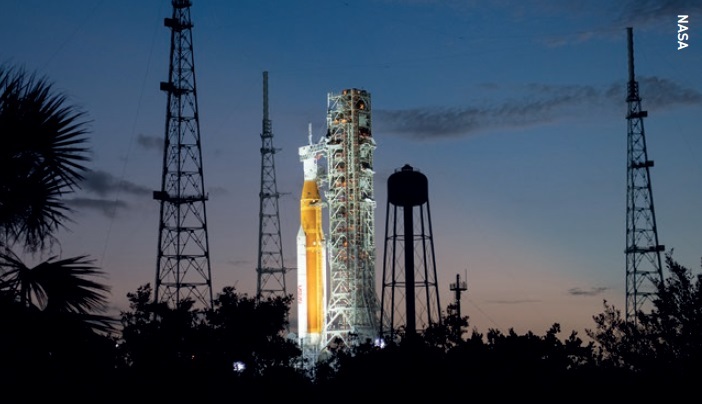 NASA’s Space Launch System (SLS) rocket with the Orion spacecraft aboard at Launch Pad 39B in November 2022.
NASA’s Space Launch System (SLS) rocket with the Orion spacecraft aboard at Launch Pad 39B in November 2022.
Lessons learned
The NASA of the 2020s is clearly intent on reinventing itself
One can hope that NASA and its Congressional overseers have learned that the size and complexity of its major programmes - the International Space Station, Space Launch System and Orion capsule - would have benefitted from a better sense of scale and smaller size. Indeed, the concern with overdesign and over-complexity seems to be confirmed by NASA’s streamlined design for its Lunar Gateway, and especially by the decision to replace the massive ISS with two smaller and much more efficient private space stations. The innovative new systems are being designed not only to be smaller, but easier to fabricate and deploy, and less costly to operate.
When the Moon exploration programme was re-examined by a blue-ribbon review team at the start of the Obama administration a decade ago, one of the key observations was that the giant size of an Orion capsule that could accommodate up to eight astronauts might be reduced to a four-astronaut configuration. Had this suggestion, outlined by Professor Norman Augustine at the time, been taken seriously the Artemis programme today might be much further ahead in schedule for a much lower cost.
The question is: why was the Orion capsule designed for eight astronauts when we are only sending four astronauts to the Moon? The good news is that NASA is learning to think smaller and more innovatively and the private space station initiative is a prime example of its learning curve.
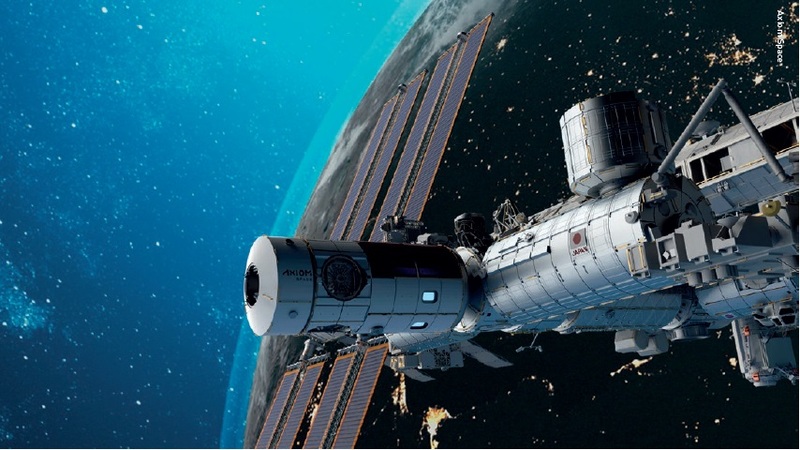 Artist’s impression of the multi-module Axiom Station. Construction of Axiom Hab One, which could accommodate four people, is already underway. The fully assembled station will be able to detach from the ISS to operate as a free-flying commercial space station after the ISS is deorbited.
Artist’s impression of the multi-module Axiom Station. Construction of Axiom Hab One, which could accommodate four people, is already underway. The fully assembled station will be able to detach from the ISS to operate as a free-flying commercial space station after the ISS is deorbited.
Private space stations
It was not NASA that first thought of private commercial space stations. There were many science fiction writers and movie producers who envisioned this type of future; Jules Verne, HG Wells and others first fired the imagination of what might be. The space station depicted in the movie 2001: A Space Odyssey gave a dazzling view of such a future in the 1960s.
Billionaire Robert Bigelow, who inherited the Budget Suites hotel business from his father, has aspired to build space hotels and was indeed the first to launch commercial enterprise efforts in this direction. He founded Bigelow Aerospace in Las Vegas, Nevada, and managed to obtain a license for the Transhab inflatable structures technology developed by NASA. This new technology was first developed to build possible structures to provide housing on Mars, but Bigelow decided that it could be used to create private space stations in Earth orbit. His company developed the Genesis 1 and Genesis 2 inflatable space structures deployed in low Earth orbit (LEO) and later an inflatable structure known as BEAM (Bigelow Expandable Activity Module) that was successfully inflated on the ISS and is now safety certified until 2028.
NASA’s new way of doing business has resulted in innovative new space facilities that can be built faster, at lower cost and are arguably better in terms of safety and reliability
Bigelow Aerospace truly pioneered the idea that commercial space stations might be commercially viable and demonstrated that such expandable structures might be safe and cost-effective systems for sustaining human life in space.
NASA first raised the idea that it might embark on a joint development with a commercial partner to create a commercial space station facility under a NASA Space Act Agreement arrangement. This approach had already been used successfully to develop private capsules to carry cargo and then astronauts to the ISS. So, NASA sought a private partner to design, build, launch and operate a private space station in partnership under a Space Act Agreement. Its proposed arrangement was that this “commercial private space station” would be first deployed as a part of the ISS and then operated as a free-flying private space station after the ISS was deorbited in 2030.
Many thought that Bigelow Aerospace, which had pioneered this type of commercial space station design, would be the winning contractor, but, after discussions, Bigelow declined to bid for such an agreement, claiming that NASA was not offering enough incentives to proceed. Instead, a totally new start-up with scientific expertise and enthusiasm - Axiom Space - won out in this process.
Article 2 of the NASA Space Act Agreement, as ultimately agreed, spells out the “Purpose” of this partnership agreement. It explicitly states the obligations of Axiom Space as follows:
“NASA enters into this Space Act Agreement in which Axiom will develop a commercially funded, developed, launched, owned and operated station module at ISS end of life (EOL). The goals of this new capability are to increase private sector involvement in low Earth orbit (LEO), to increase the robustness and operational throughput to the ISS, and ensure a successful transition of ISS-based commercial LEO utilization to a commercial platform at ISS EOL. Axiom has proposed to design and develop a commercial crewed ISS module that could host as many as seven (7) crewmembers, including astronauts and spaceflight participants.”
NASA’s approach to future exploration and science programmes is to de-orbit the ISS and replace this outmoded facility with ‘private’ space stations
From that start, Axiom Space has moved ahead aggressively on all fronts. Although NASA, under this agreement, commissions the building of only one module, the current planning envisions a much more ambitious programme and Axiom Space has plans to engineer, manufacture and deploy five additional modules.
As now conceived, the full deployment would include:
- the AxH1 habitation module that could accommodate four crew members now under construction and planned for launch in 2024 under the NASA Space Act Agreement
- the AxSEE-1 space entertainment enterprise studio module that might be launched in late 2024 or early 2025
- the AxH2 habitation module that could accommodate four crew members
- the AXRMF which would be a research and space fabrication unit
- the AxEO module for Earth observation that would have a large window for viewing Earth and space
- the AxPT ‘power tower’ that would allow the deployment of a large solar array. This last module is essential for powering the Axiom space station when it detaches from the ISS and becomes an independent space station (see www.axiomspace.com/axiom-station).
This may seem to some like science fiction but Axiom Space has contracts underway with Thales Alenia to build the first habitat, AxH1, as well as a follow on AxH2. It has been raising private capital and hiring experienced staff, such as veteran astronaut Michael López-Alegría. In April 2022 López-Alegría and three other Axiom astronauts (each paying $155 million) travelled on a SpaceX Dragon spacecraft to the ISS for a 17-day mission. As a start-up, Axiom Space has established its credibility in a short period of time.
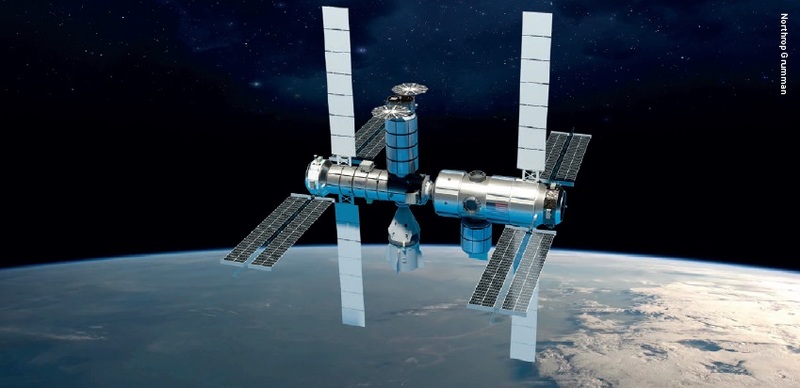 Northrop Grumman’s proposed space station focuses on delivering an accessible, space-as-a-service station in low Earth orbit that will continue the work of the ISS while expanding across multiple markets to support a new commercial space economy.
Northrop Grumman’s proposed space station focuses on delivering an accessible, space-as-a-service station in low Earth orbit that will continue the work of the ISS while expanding across multiple markets to support a new commercial space economy.
Second station
Axiom Space has plans to engineer, manufacture and deploy five additional modules
NASA’s follow-on effort to obtain a second private space station followed a different course. Under a new programme announced in 2021, it selected three finalists from nearly a dozen candidates to develop the design. The chosen finalists are Northrop Grumman Aerospace, Blue Origin with a number of notable aerospace partners, and a design backed by Nanoracks, Voyager Space and Lockheed Martin.
Northrop Grumman was given an initial award of $125.6 million to develop a comprehensive space station design which received high marks in the NASA design review process. These favourable comments included having the most conventional metal-based cylindrical tube design (which translated into a high-level of confidence of successful fabrication and deployment) of a four-astronaut habitat of proven technical maturity; a good training programme; and a good concept and planning for ground support.
Also noted was a good maintenance plan and the inclusion of a robotic arm in the design, which is a feature that would limit the need for extra-vehicular activities. However, on the commercial viability of the NGC plan there were concerns about the ability to attract commercial support for this space station and the limited financial investment that NGC was offering in its proposed business plan. Subsequently, additional capital investment was offered by Northrop Grumman.
Perhaps the opposite extreme to the Northrop Grumman proposal is Blue Origin’s Orbital Reef space station with its large and growing number of partners and its significant design complexity. It even includes the development of a proposed new single person spacecraft for a variety of uses. Orbital Reef partners include:
- Sierra Space, a subsidiary of Sierra Nevada, that will be responsible for manufacture of the Large Integrated Flexible Environment (LIFE) module as well as a follow-on module. Sierra Space may also be involved in the use of the Dream Chaser spaceplane for crew and cargo transport.
- Boeing to be responsible for the science module and for the operation and maintenance of the space station.
- Redwire Space to oversee microgravity experiments.
- Genesis Engineering Solutions (GES) to develop a single person spacecraft that could be a part of the space tourism experience.
- Arizona State University that would head a global consortium of universities to support space research activities.
The envisioned final design for the Orbital Reef includes a ‘space entertainment module’ that would allow the filming of movies and other entertainment in orbit.
This ambitious design has passed the NASA Systems Requirements Review and has been subject to comment about all of its various component parts, and its many partners. One concern related to the launch of the habitat module being dependent on the timely development of the New Glenn launcher and the timely availability of the BE-4 rocket motors that Blue Origin is developing.
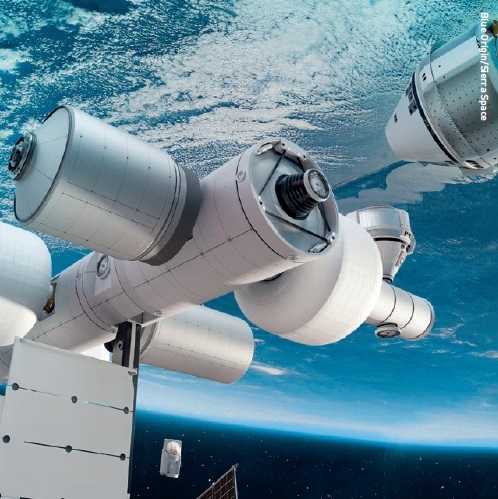 The Orbital Reef private space station is intended to be a ‘mixed-use business park’ in low Earth orbit for research, industrial, international and commercial customers offering cost competitive end-to-end services including space transportation and logistics, space habitation, equipment accommodation and operations including onboard crew.
The Orbital Reef private space station is intended to be a ‘mixed-use business park’ in low Earth orbit for research, industrial, international and commercial customers offering cost competitive end-to-end services including space transportation and logistics, space habitation, equipment accommodation and operations including onboard crew.
Starlab, the third private space station design – from Nanoracks, Voyager Space and Lockheed Martin – has a striking design element in that it calls for the uninflated habitat module, the solar array power and propulsion system, the docking port, the metallic laboratory module and the robotic arm manipulator to be launched on a single heavy lift rocket.
The envisioned final design for the Orbital Reef includes a ‘space entertainment module’ that would allow the filming of movies and other entertainment in orbit
The key here is that the habitat module is an inflatable unit, such as the BEAM that has been tested and deployed on the ISS. The fully deployed habitat is to expand to a huge 340 cubic metres (12,000 cu ft).
Nanoracks’ experience with the deployment of student and small scientific satellites has helped this proposed private space station to focus on the scientific needs and technical requirements of the commercial, academic and scientific community.
On 8 December 2021, Nanoracks announced a consortium of universities and industries as the first participants in the ‘George Washington Carver (GWC) Science Park’, the first science park in space, which forms the core of Starlab. This initiative begins on the ISS and is to transfer to Starlab when deployed.
Much more could be said about each of these three designs and the related technology and business plans, but it is perhaps best to await the final details that will be included in the NASA Space Act Agreement with the final chosen partner.
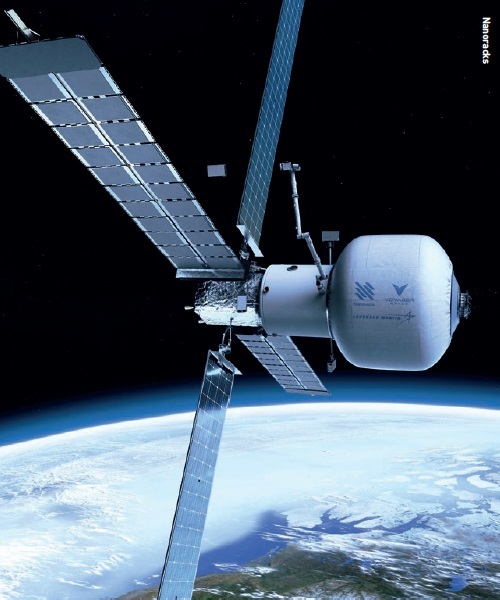 Starlab will be a continuously crewed commercial platform, dedicated to conducting critical research and fostering industrial activity in low Earth orbit. Starlab’s habitat module is an inflatable unit and the fully deployed habitat would expand to a huge 340 cubic metres (12,000 cu ft).
Starlab will be a continuously crewed commercial platform, dedicated to conducting critical research and fostering industrial activity in low Earth orbit. Starlab’s habitat module is an inflatable unit and the fully deployed habitat would expand to a huge 340 cubic metres (12,000 cu ft).
Key questions
The real challenge is whether these demanding ventures by Axiom Space and the other NASA partners can truly generate about half their revenues from commercial space adventurers, space science experiments and tests, and other activities such as space movies and advertisement revenues. Indeed, can this market support two free-flying private space stations in low Earth orbit?
One thing is clear. The scale of the private space stations and the economics of designing, deploying and operating them in low Earth orbit will be much less costly than the ISS, which is to be de-orbited in 2030. The first modules of these two two private space stations may be launched as early as 2027 or 2028, giving NASA some flexibility as to when the ISS is deorbited, but other questions remain.
As ever, the technologies and innovations of space are ahead of our institutions, which are not ready for tomorrow’s new reality
Key among the concerns is how long a viable market can be maintained wherein billionaires or companies pay more than $50 million to fly and stay in space. Another key question relates to who carries out the safety certification of private stations in terms of their design, deployment and operation.
The author has argued the case for the creation of such a new international certification and safety research entity in his book - The Space Safety Institute: A New Way to Safety Certification in the NewSpace Age - while his recently released 21st Century Space Stations: New Approaches to Space Safety suggests that there are more than a dozen other questions about the safe design, deployment, operation, insurance and institutional arrangements that need to be addressed.
The roles of space agencies, commercial space entities and institutional oversight and regulatory institutions need to change in the coming decades. As ever, the technologies and innovations of space are ahead of our institutions, which are not ready for tomorrow’s new reality.
About the author
Joseph N Pelton, Chairman of the Alliance for Collaboration in the Exploration of Space (ACES Worldwide), is the award-winning author of some 50 books including The Space Safety Institute: A New Way to Safety Certification for the NewSpace Age, and 21st Century Space Stations: New Approaches to Space Safety (both available at Amazon).





